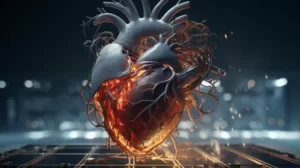It’s a startling fact that heart disease is the leading cause of death for both men and women in the United States. What’s even more alarming is that for most victims, the sudden cardiac arrest that often causes a heart attack is usually the first indication of an issue. But recent research at Cedars-Sinai Medical Center has discovered that there may be early warning signs we simply aren’t picking up on.
The Warning Signs You May Be Missing
According to the study, some warning signs of a heart attack may present themselves up to four weeks before the actual event. Recognizing and addressing these signs could potentially save thousands of lives. Of course, chest pain and difficulty breathing are the most common indicators that you may be on the verge of experiencing a heart attack.
But the study revealed that 20% of patients who experienced symptoms also reported abdominal pain, nausea, vomiting, and back pain. Additionally, 10% reported flu-like symptoms, and 5% said they fainted. The issue lies in the fact that many people aren’t aware of these less-common warning signs and often attribute them to less severe conditions.
Looking back, only 19% of the patients sought emergency help. Though it can be difficult to pinpoint a surefire warning signal, when it comes to your health, it’s better to err on the side of caution and get checked out by a medical professional.
Factors That May Increase Your Risk
You can never be too cautious when it comes to your health, particularly if you have a history of heart disease. Even young adults with a family history of conditions such as diabetes or high blood pressure should pay close attention to those lesser-known warning signs and consider seeking medical advice if they experience them.
Though these symptoms may very well turn out to be the flu or some other benign ailment, keep an eye on them and, should they recede then reoccur within a 24-hour window, act quickly. Being proactive in recognizing and addressing potential symptoms of a heart attack could be the difference between life and death.
Protecting Your Heart
An alarming statistic from the American Heart Association states that nearly 70% of the U.S. population has some form of heart disease. For years, cholesterol has been labeled as the primary culprit, with statins being prescribed to counter its effects. While statins may indeed lower cholesterol, they also deplete the body of CoEnzyme Q10 (CoQ10). Insufficient levels of CoQ10, which provides essential cellular energy, can result in heart failure.
In addition to this, statins can cause muscle fatigue, which is particularly concerning since the heart is our body’s most significant muscle. In lieu of relying solely on cholesterol-lowering drugs, there are several simple, cost-effective lifestyle changes you can make to improve your heart health and decrease your risk of heart attack.
For starters, increasing your fiber intake can make a substantial difference. In a study comparing Chinese adults to Americans, the Chinese individuals had triple the fiber intake, a much lower average cholesterol level (127 mg/dL compared to the Americans’ 203 mg/dL), and a death rate 16.7 times lower than American men.
Knowing your body well enough to recognize the potential signs of a heart attack is essential and potentially life-saving. But the benefits of taking proactive, preventative measures cannot be understated. To maintain a healthy heart, consider incorporating more heart-healthy habits into your lifestyle, such as a diet rich in fiber and regular exercise. Making these simple changes can not only help ward off potentially serious heart issues down the line but also contribute to overall better health.



